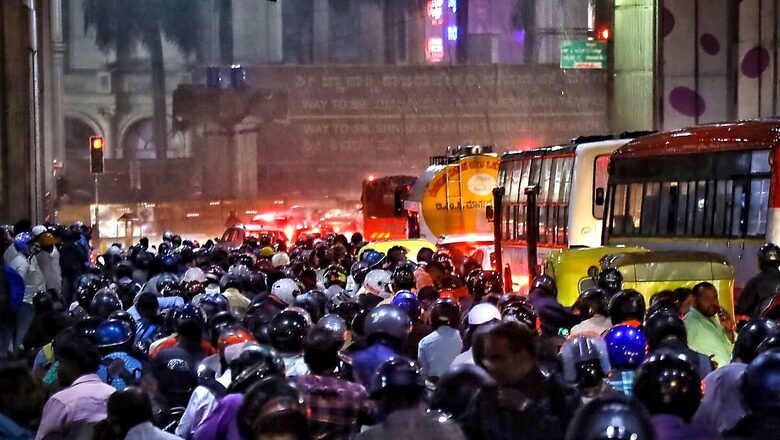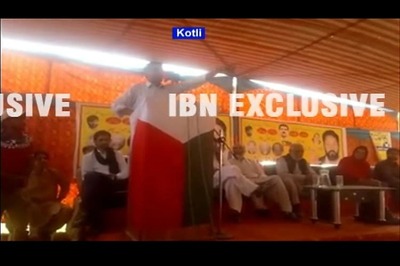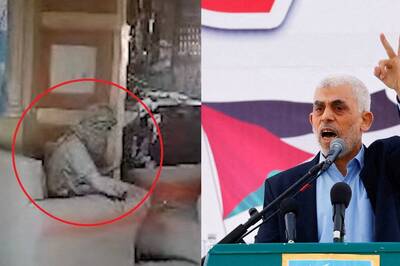
views
The city’s traffic trauma has had several governments in Karnataka on the edge and the present Congress government in the state has set its sights on building at least a four-lane tunnel road, which could cost upwards of Rs 50,000 crore.
While a good solution is welcome to relieve motorists of traffic jams and long hours of commute, urban mobility experts may be seeing the proposed plan with tunnel vision.
The solution for the issue, as seen in different cities across the world, has been creating a robust and well-oiled public transport system — one that seamlessly blends between public and private transportation.
However, decisions like these, which though seem glamorous on paper, do not add much as a solution for the future. The roads continue to shrink due to the increasing number of vehicles, and the public transport system also ends up getting caught in the jam.
The traffic on Bengaluru roads is in the ratio of 1:1. Approximately 65,000 employees travel to work in companies located on the outer ring road (ORR), with nearly 3,38,800 vehicles on the road every single day. This includes employees taking their vehicles to work, apart from vehicles ferrying schoolchildren, college students, and vehicles of other businesses.
As expected, there has been a steep increase in the number of vehicles by another 75,000 between August and September this year as many companies opened their offices full time.
Let’s not forget that while such decisions are being made with the best interest of the public in mind, there is a catch. A decision taken by one government is not necessarily carried forward by a subsequent government as politics seeps in.
Karnataka Deputy Chief Minister DK Shivakumar on Thursday announced that the government will float a global tender in the next 45 days to build tunnels spanning 190 kilometres at different locations known as high-density areas in Bengaluru. He added that eight companies qualified for the tender process.
A detailed study on how long the tunnel road should be, the need for four or six lanes, and the entry and exit points of the tunnel road, was conducted and a report is expected to be submitted. Based on that, a decision will also be taken on whether to extend it to other parts of Bengaluru city.
Shivakumar feels Bengaluru needs at least a four-lane tunnel road. The building of tunnel roads and elevated corridors was proposed by KJ George during his tenure as Bengaluru development minister in the previous Congress regime, and Shivakumar feels it is the right time to implement it.
Urban experts like Ravichandar stress that the answer for Bengaluru’s traffic woes is, without a doubt, public transport.
“There can be no other proof of the importance of public transport,” he says. “Can we ring-fence city roads from the corruption that plagues our system? Can we do it in a way the roads elsewhere in the states are being done? If you want to fix the issue, you must upscale public transportation and ring-fence the roads from corruption,” he said in an earlier interview.
The proposed 190-km tunnel will expand from Bellary Road, Old Madras Road, Esteem Mall Junction to Mekhri Circle, Miller Road, Chalukya Circle, Trinity Circle, Sarjapur Road, Hosur Road, Kanakapura Road to Krishna Rao Park, Mysore Road to Sirsi Circle, Magadi Road, Tumakuru Road to Yeshwantpur Junction, Outer Ring Road, Goraguntepalya, KR Puram to Silk Board.
At present, several parts of Bengaluru are choked, or roads narrowed with the ongoing construction of the Namma Metro and unfinished elevated corridors or flyovers.
That also reminds of another ambitious project — the steel flyover that was initiated in the previous Siddaramaiah government but shelved after stiff resistance from the public and social activists.
The project was a proposal to build a 6.7-kilometre-long steel flyover from Basaveshwara Circle to Hebbal Junction at a cost of Rs 1,761 crore, which the then Congress government said was to improve connectivity to the airport and relieve Bengaluru from traffic congestion. Activists protesting said more than 800 trees would have been felled to make way for the flyover.
So, here is an example of politics seeping in. In the second term of the Congress, Shivakumar once again raked up the issue and commented that he would not have “cowered” for any reason from going ahead with the steel flyover project.
“In the previous Siddaramaiah government, a move was made towards building a steel bridge. There was such huge uproar and criticism, and drums were beaten to say there was bribery and corruption. Siddaramaiah feared it. He and George said no to it,” he said.
Karnataka’s home minister Dr G Parameshwara has also stepped in with suggestions to help ease traffic, including using drone cameras to monitor traffic at junctions.
Setting a three-month deadline for the police department to find solutions and clear traffic congestions, the minister has also emphasised that the department, which had been tasked in 2018 to install around 7,000 high-resolution cameras, should continue to complete setting up the remaining 2,700 cameras across the city.
Infrastructure development for a city is like a relay game — passing the baton from one government to another without dropping it, ensuring that at the end of the race, both the citizen and the government are winners.




















Comments
0 comment